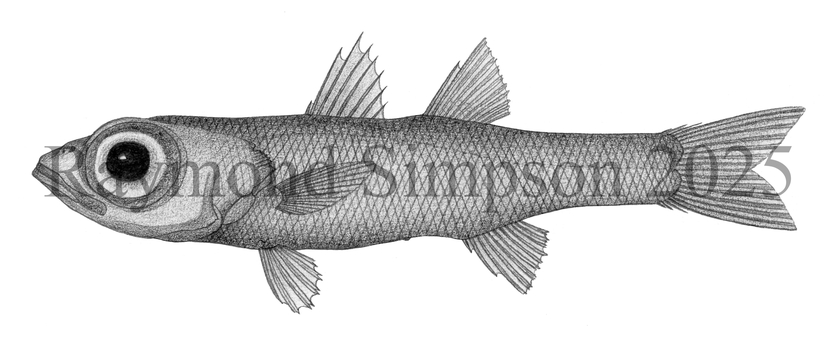
Common Name
Luminous Deepsea Cardinalfish
Year Described
Brauer, 1906
Identification
Dorsal Fin: VIII-I, 10 (rarely VII or 9 rays)
Anal Fin: II, 9 (rarely 10)
Pectoral Fin: 18-19
Lateral Line: 46-50
Gill Rakers: 17-21 (first arch)
Vertebrae: 10+15 = 25 total
Body slender and laterally compressed. Large terminal mouth. Teeth conical. Premaxillary teeth enlarged and visible on closed mouth. Lingual and endopterygoid teeth absent. No enlarged teeth present at lower jaw symphysis. Maxillary process absent. Opercular spine absent. Numerous spinelets on opercular margin. Pyloric caeca 7-8. First dorsal spine tiny. Lateral line complete and composed of pored scales. Luminous organ on belly.
Color
Body metallic copper-brown to brownish-black with blue sheen on the flanks and opercle. Belly paler. Fins with dark membranes. Eye black. Young fish with a oblique thin band on caudal peduncle.
Size
Maximum size to 206mm SL.
Habitat
Found near the bottom over hard bottoms and structure (550-1100m) but most common between 640-920m. Juveniles more pelagic.
Range
E. Florida to French Guiana, including the Caribbean Sea and Gulf of Mexico.
References
Mayer, G. F. 1974. A revision of the cardinalfish genus Epigonus (Perciformes, Apogonidae), with descriptions of two new species. Bulletin of the Museum of Comparative Zoology v. 146 (no. 3): 147-203.
Okamoto, M., Baldwin, C. C., & D. J. Long. 2024. Two new species of the deepwater cardinalfish genus Epigonus (Epigonidae) from deep reefs off Curaçao, southern Caribbean. Ichthyological Research, 71(3), 1–10.